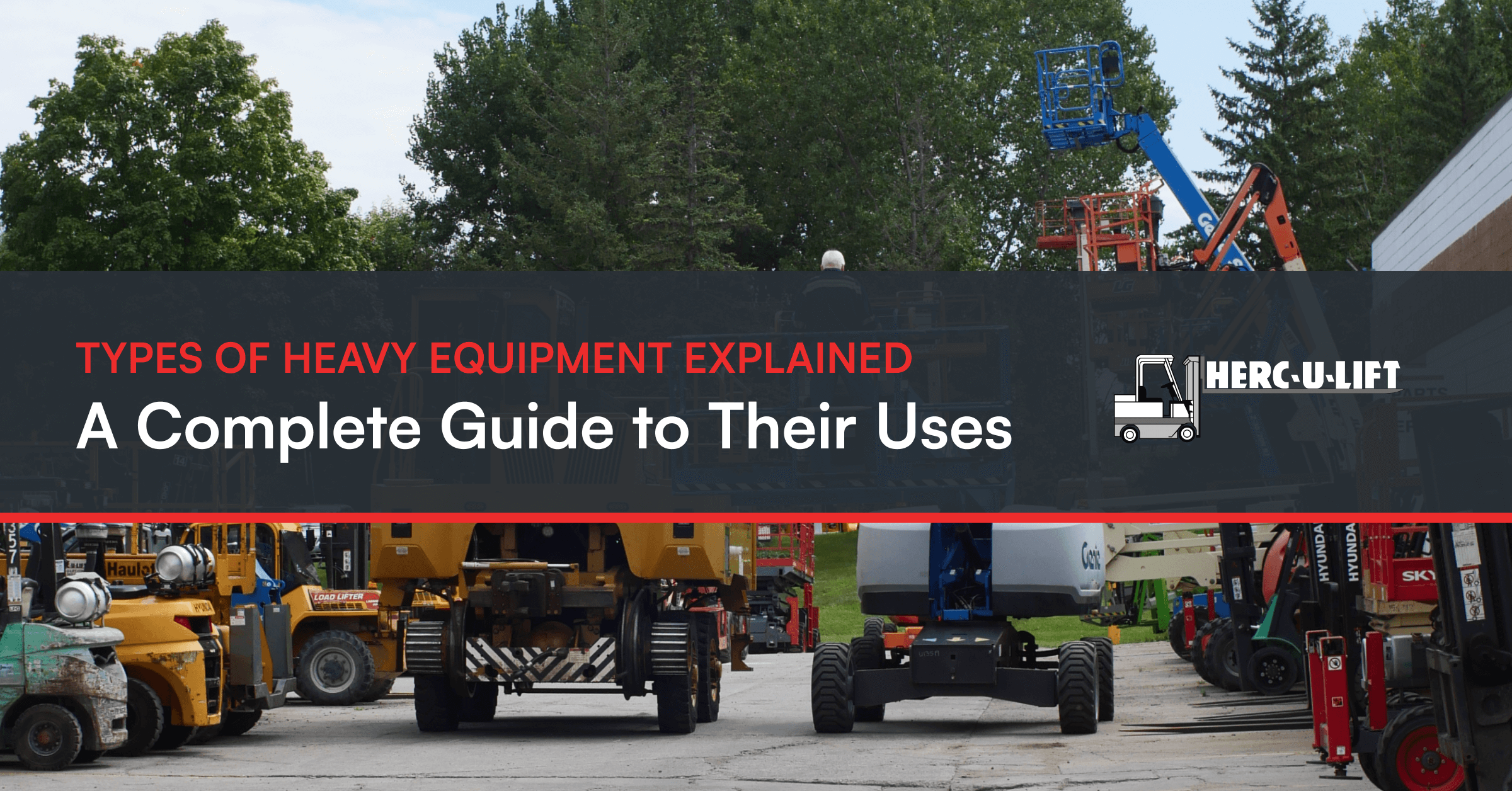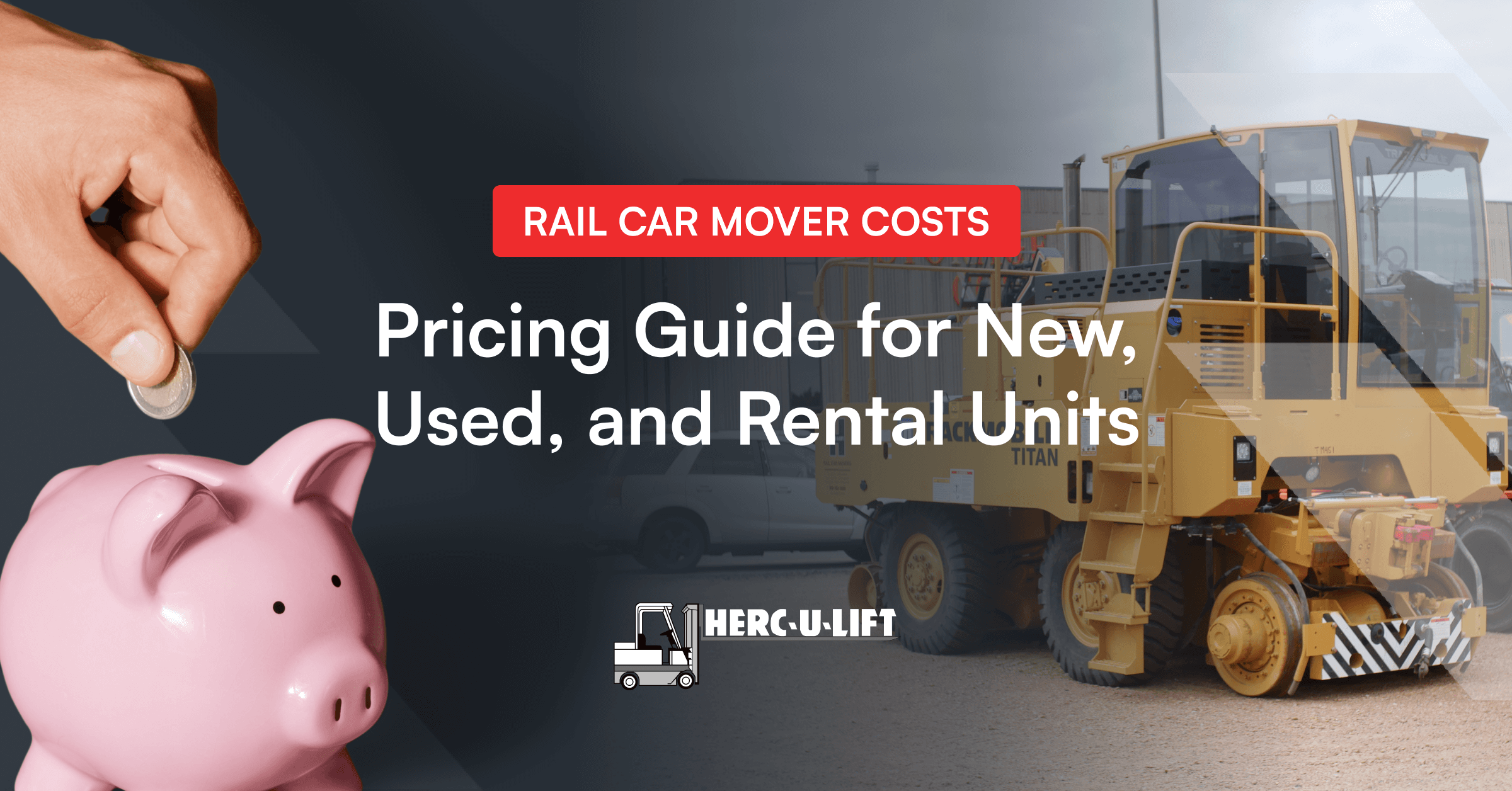Types of Heavy Equipment Explained: A Complete Guide to Their Uses

Ever tried driving a nail with the handle of a screwdriver? Sure, you might get the nail halfway in. But it will definitely take longer, you’ll probably bend the nail, and the tool won’t thank you for it. Scale that mistake up to an industrial level, and the consequences can get expensive pretty quickly.
A poor fit between machine and task can create serious challenges. It increases operating costs, slows projects, and reduces efficiency. In some cases, it even puts workers at serious risks. Imagine using a forklift where a telehandler is needed. You’ll spend the day struggling with reach limitations, safety hazards, and frustrated operators. The machine works, but is not suited for purpose.
Understanding which machine aligns with your specific needs is important. It forms the foundation of safe, cost-effective operations.
Heavy equipment experts have worked for several years in and around construction sites, warehouses, and industrial plants. In these environments, it is clear how the right machine can transform productivity. At one manufacturing plant, for instance, an outdated milling machine was replaced with a CNC system. The result was a 30% increase in throughput, achieved without requiring additional labor.
So yes, choosing the right machine for the job matters.
In this article, we’ll guide you through the basics of machinery. We’ll share about the common categories you’ll encounter and the thought process you need to make the best choice. Think of this blog as a practical roadmap for matching your machine with your mission.

To illustrate, a hammer is a tool, while a hydraulic press is a machine.
Machines are built to handle heavy or repetitive work while minimizing error. They achieve speeds and safety levels beyond what human effort alone can provide. Case in point, a skid steer can easily do the work of a full shovel crew.
Machines have greatly improved over the last few decades. Sensors, AI, and hydraulics now make them more powerful and easier to use. The result? Today’s machines go beyond function. They’re also reshaping how industries build, move, and produce.
Main Categories of Machines
By Industry Application
Different industries rely on different types of machines. Let’s break them down:
Manufacturing Machines
When precision is the name of the game, manufacturing machines take the spotlight. This industry runs on consistency, speed, and accuracy. That’s where specialized machines step in. These systems do everything from shaping metal parts to drilling precise holes. In short, they are invaluable for modern production lines.
CNC machines
Computer-controlled systems that cut, shape, and drill with precision. They’re commonly used in mass production.
Lathes
Machines that rotate a workpiece against a cutting tool. They shape it into symmetrical parts like shafts or bushings.
Milling machines
Cut and shape solid materials (such as metal, plastic) with remarkable accuracy.
Construction Machines
This is where the heavy hitters come in. Construction machines are versatile and powerful. They are often designed to tame everything from dirt to concrete. These equipment can dig foundations, lift workers skyward, or push earth into place.
Excavators
A do-it-all construction equipment. They can dig, lift, demolish, and more.
Bulldozers
Push earth and level terrain with raw power.
Concrete mixers
Essential for projects that need consistent, fresh concrete delivered.
Scissor lifts
Provide vertical access to workers. They’re used for electrical installations or ceiling maintenance jobs. These mobile ladders can position people exactly where they need to be.
Boom lifts
Extend upward and outward. They are useful for exterior façade work or for reaching inaccessible spots.
Telehandlers
Combine the power of a forklift and a crane. They shine in moving pallets, materials, and loads to heights or hard-to-reach spots.
MEWPs (Mobile Elevating Work Platforms)
Is the catch-all term for lifts designed to safely position workers at height.
Agricultural Machines
Farming machines perform planting, harvesting, and hauling tasks. They work with speed and consistency while maximizing productivity.
Tractors
Farmer’s everyday essential. They pull, push, plow, and tow with versatility.
Harvesters
Take the manual labor out of crop collection. They also cover vast land areas in a fraction of the time.
Seeders
Machines that automate planting. They ensure even spacing and depth for optimal crop growth.
Telehandlers
also handy on farms as they are on construction sites. They can move bales, feed, and supplies with ease.
Transportation and Logistics Machines
These machines keep goods flowing. They move pallets in a warehouse, freight cars on rails, or products along a conveyor line. Without them, supply chains would be delayed.
Forklifts
Move pallets and load trucks in warehouse settings. These machines make material handling efficient and easy.
Conveyor systems
Machines that keep factories and distribution centers moving. They keep the goods flowing from one point to another.
Rail Car Movers
Specialized vehicles that can switch between paved roads and rail tracks to move freight cars in industrial settings.
Food Processing Machines
These machines are essential to modern food production. They ensure products meet strict standards while keeping pace with consumer demand. In short, they’re the silent yet practical equipment behind what ends up on store shelves.
Mixers and grinders
Turn raw ingredients into consistent mixtures that meet exact specifications.
Packaging equipment
Automates labeling, sealing, and boxing. Without them, businesses will need huge teams of workers and still fall short on consistency.
By Function
You can also classify machines by the jobs they perform. For example, milling machines and CNCs are for cutting and shaping raw materials. Forklifts and telehandlers move and lift objects around a job site.
Food processors, bottling lines, and textile machines process and package materials into finished goods. CMMs (coordinate measuring machines) and inspection systems are for testing and measuring. Meanwhile, industrial vacuums, pressure washers, and floor scrubbers are for cleaning and maintenance.

Choosing the Right Machine: Key Factors
Focus on a machine’s performance and capacity. Consider speed, load limits, reach, and cycle times. Pick one that aligns with your business needs.
Power Source
Electric-powered machines suit indoor work while diesel excels outdoors. Hydraulics balance raw power with precision.
Ease of Operation and Training Requirements
User-friendly controls and built-in support simplify operation. However, keep in mind that some machines require operators to undergo specialized trainings.
Durability and Maintenance
A cheap machine that constantly requires repairs is a bad investment. Strong build quality and easy availability of parts will keep your operation running smoothly. In many cases, it can be even more cost-effective to rent equipment instead of buying.
Safety Features
Emergency shutoffs, stability controls, and other extra safeguards can protect your people and equipment. Additionally, learn about compliance requirements from OSHA, ANSI, or your existing local regulations.
Manufacturer Reputation and After-Sales Support
A reliable supplier ensures timely service and provides customer support when needed. For rentals, providers usually take care of regular maintenance and troubleshooting. If a machine breaks down, they can arrange a replacement or repair quickly, minimizing downtime, avoiding unexpected repair costs, and keeping the project on track. In many cases, this can be the difference between a 1-day problem and a 3-week shutdown.
To sum up, the right machine not only makes the job easier. It safeguards your investment and protects your workforce. You achieve your purpose while getting your money’s worth.
Another common trip-up is ignoring compatibility. Machines don’t exist in a vacuum. They need to play nicely with the rest of your operation. A conveyor that doesn’t sync with production lines or a forklift that won’t fit standard pallets isn’t just annoying; it’s a long-term headache that can drag efficiency down for months.
Then there’s the temptation of the “bargain buy.” A low sticker price looks great on paper—until you realize the parts are hard to source or the only certified tech is three states away. Downtime waiting for a fix can cost more than the machine itself.
Here’s the hard truth:
“A cheap machine rarely pays off in the long run.”
Finally, failure to vet suppliers can be a disadvantage. Ideally, a dealer should do more than offer machines. They should provide ongoing service and technical support.
Real-World Examples
Manufacturing Plant Case Study
A mid-sized metal fabrication company upgraded from manual lathes to CNC machines. Within six months, their production capacity increased by 30%. Scrap rates dropped significantly and operator safety improved. The upfront investment was substantial, but the ROI came faster than expected. It’s all because the machines paid for themselves through improved efficiency and reduced waste.
Farm Case Study
A corn farmer switched from older harvesters to modern GPS-equipped combines. As a result, crop loss reduced significantly and fuel use went down. Moreover, harvesting time was cut nearly in half.
The right machine didn’t just improve efficiency. It also boosted profitability by reducing both operating costs and crop waste.
Emerging Trends in Machinery
Machines are changing fast nowadays. It even feels like they’re evolving as quickly as the industries they serve. Staying updated is no longer optional. It’s survival. Miss a key shift and you risk falling behind competitors who are already two steps ahead.
A few big trends are reshaping the way companies buy, use, and take care of their machines, namely:
Together, these trends show us where the future is headed. Machines are no longer just tools. They’re now becoming intelligent partners that drive efficiency, safety, and sustainability in a job site.


